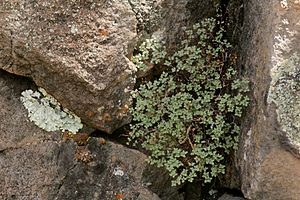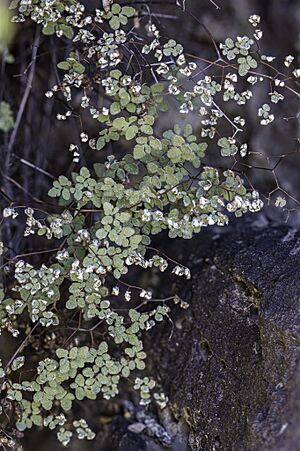Argyrochosma fendleri facts for kids
Quick facts for kids Argyrochosma fendleri |
|
|---|---|
 |
|
| Argyrochosma fendleri growing in a rock crevice | |
| Conservation status | |
| Scientific classification | |
| Genus: |
Argyrochosma
|
| Species: |
fendleri
|
| Synonyms | |
|
|
Argyrochosma fendleri, also called Fendler's false cloak fern, is a type of fern. You can find it in the western United States and northwestern Mexico. This fern likes to grow in rocky places. It's special because its leaf stems have a zig-zag shape. Like many ferns in its group, it has a white powder on the underside of its leaves. This fern was first described in 1851. Later, in 1987, it was moved into a new group called Argyrochosma, known as the "false cloak ferns." This was done to show they are different from other "cloak ferns."
Contents
What Does Fendler's False Cloak Fern Look Like?
Argyrochosma fendleri is a medium-sized fern that grows on rocks. It has a small, tight underground stem called a rhizome, which is about 2 to 3 millimeters (0.08 to 0.12 inches) wide. This rhizome can grow sideways or straight up.
Leaves and Stems
The rhizome has thin, orange-brown scales that are 7 to 10 millimeters (0.28 to 0.39 inches) long. Many leaves grow from this stem in thick bunches. Each leaf, from its base to its tip, is about 5 to 25 centimeters (2 to 10 inches) long and 5 to 12 centimeters (2 to 5 inches) wide.
About half of the leaf's length is the stipe, which is like the leaf's stalk. It's round, smooth, and chestnut-brown. The stipe is usually 0.75 to 1.5 millimeters (0.03 to 0.06 inches) thick and 3 to 16 centimeters (1 to 6 inches) long.
Leaf Blades
The main part of the leaf, called the blade, is shaped like a triangle. It's very divided, with many smaller sections. Sometimes, the blade is wider than it is long. When the leaves dry, they curl up a little.
The main stem of the leaf blade, called the rachis, is round and smooth. It has a special zig-zag shape instead of being straight. Each blade has 4 to 6 pairs of smaller leaf sections called pinnae. The stems of these pinnae also zig-zag, with even smaller parts branching off at the corners.
The smallest leaf parts are oval or oblong. Their tips are rounded, and their bases are wedge-shaped. Sometimes, their edges have rounded teeth. The dark color of the stems extends into the base of these small parts. The pinnae and their smaller sections grow on long stalks.
Special Features
The underside of the leaf is covered in a pale white powder called farina. Sometimes, you can also find a few glands and powder on the top surface. The leaf tissue feels tough, almost like leather.
Reproduction
The fern's sori (clusters of spore cases) are found along the veins of the leaf, near the edges. The edges of the leaf are not changed to cover the sori. They can be flat or curled under to protect the sori. Each sporangium (spore case) holds 64 spores. These plants are diploid, meaning they have two sets of chromosomes, with a total of 54 chromosomes.
The zig-zag shape of the main leaf stem and its branches helps tell this fern apart from others in its group. Another fern, A. limitanea, might have slightly zig-zag stems, but its branches are not as spread out. Also, A. limitanea reproduces differently and only has 32 spores per sporangium.
How Fendler's False Cloak Fern Got Its Name
This fern was first described in 1851 by Gustav Kunze. He named it Notholaena fendleri after Augustus Fendler, who collected the plant in New Mexico.
Over the years, scientists found it hard to group ferns correctly. So, this fern was moved to different groups by different scientists. For example, Fée moved it to Cincinalis in 1852. Later, Mettenius put it in Gymnogramma in 1859. Prantl then moved it to Pellaea in 1882. In 1979, John T. Mickel placed it in Cheilanthes.
By the late 1900s, many experts thought that Notholaena nivea and similar ferns, including N. fendleri, might belong in their own unique group. In 1987, Michael D. Windham did studies on these ferns. He created a new group called Argyrochosma and moved this fern into it, naming it A. fendleri. In 2018, Maarten J. M. Christenhusz moved it to Hemionitis, calling it H. engywookii. This new name refers to a gnome scientist named Engywook from the book The Neverending Story.
Studies have shown that A. fendleri is a very old and unique branch on the fern family tree. It's different from other Argyrochosma ferns that have white powder. Its powder is also special because it's made mostly of a rare chemical called eriodictyol-7-methyl ether.
Where Fendler's False Cloak Fern Lives
You can find Argyrochosma fendleri in the United States in New Mexico, Colorado, and the southeastern part of Wyoming. It also grows in Sonora, Mexico.
It prefers to grow on rocky cliffs and slopes, especially on rocks like granite and other igneous rocks. It's the only fern in its group that likes this kind of rock. It grows at high altitudes, from about 1,700 to 3,000 meters (5,600 to 9,800 feet) above sea level.
Protecting This Fern
According to the NatureServe conservation status system, A. fendleri is considered vulnerable (G3). This means it's at moderate risk of disappearing. In Wyoming, it's thought to be in critical danger, and in Colorado, it's considered vulnerable.
Growing Fendler's False Cloak Fern
The plant expert George Schneider believed this fern was good for growing. He noted that it "thrives well under cool treatment," suggesting it might do better in cooler conditions than some tropical ferns.



